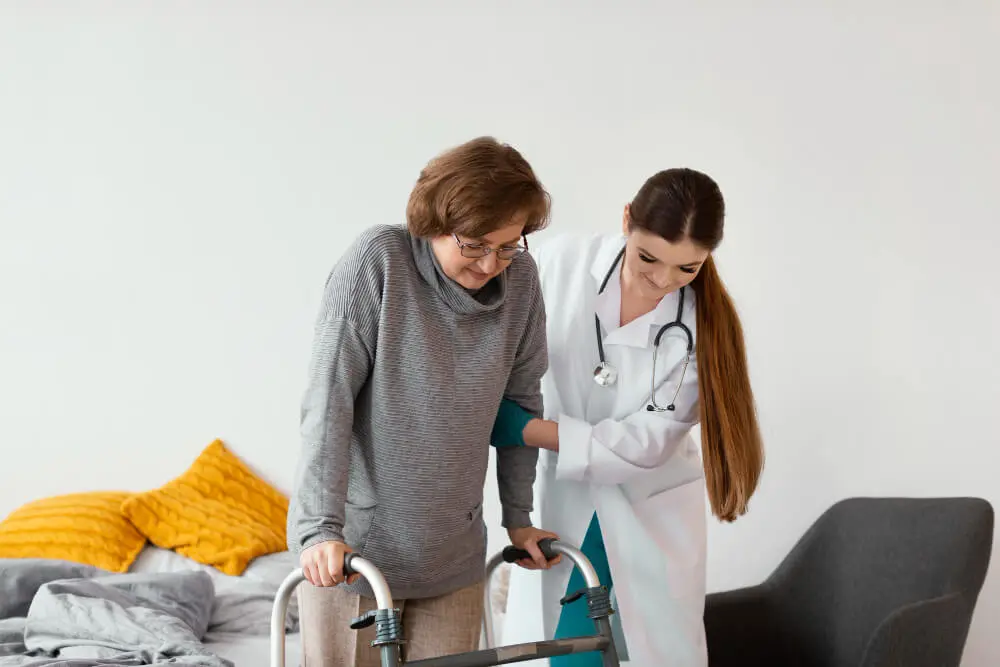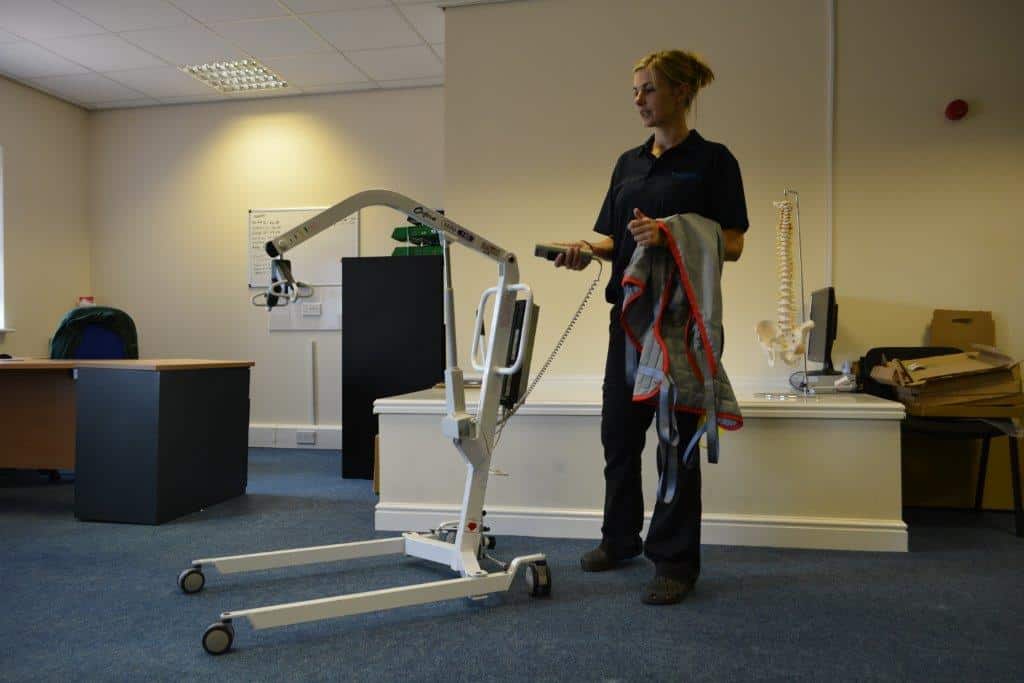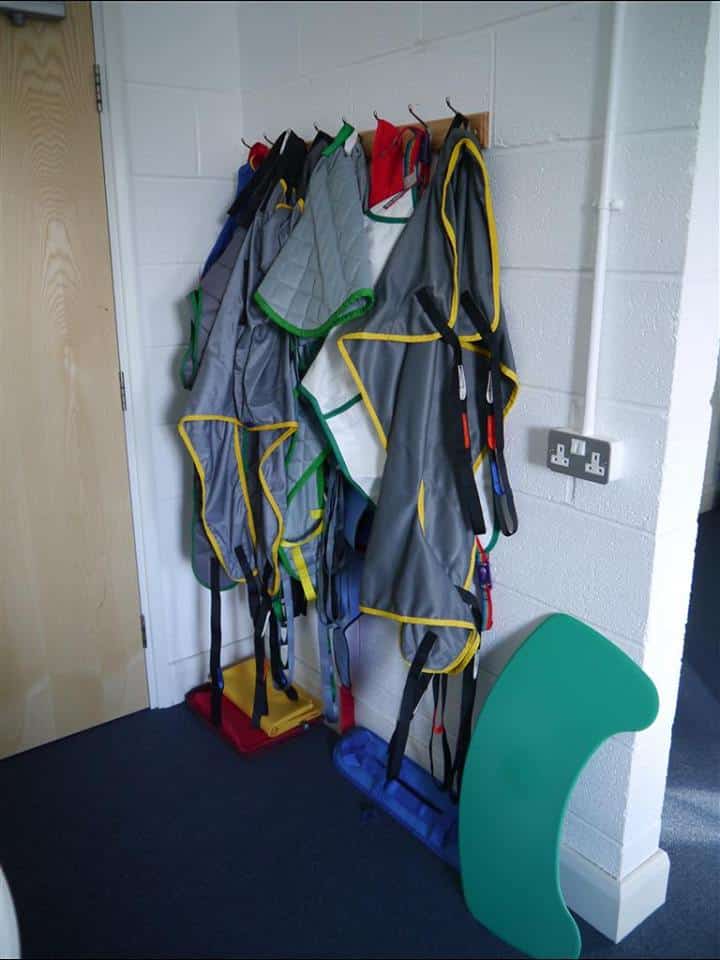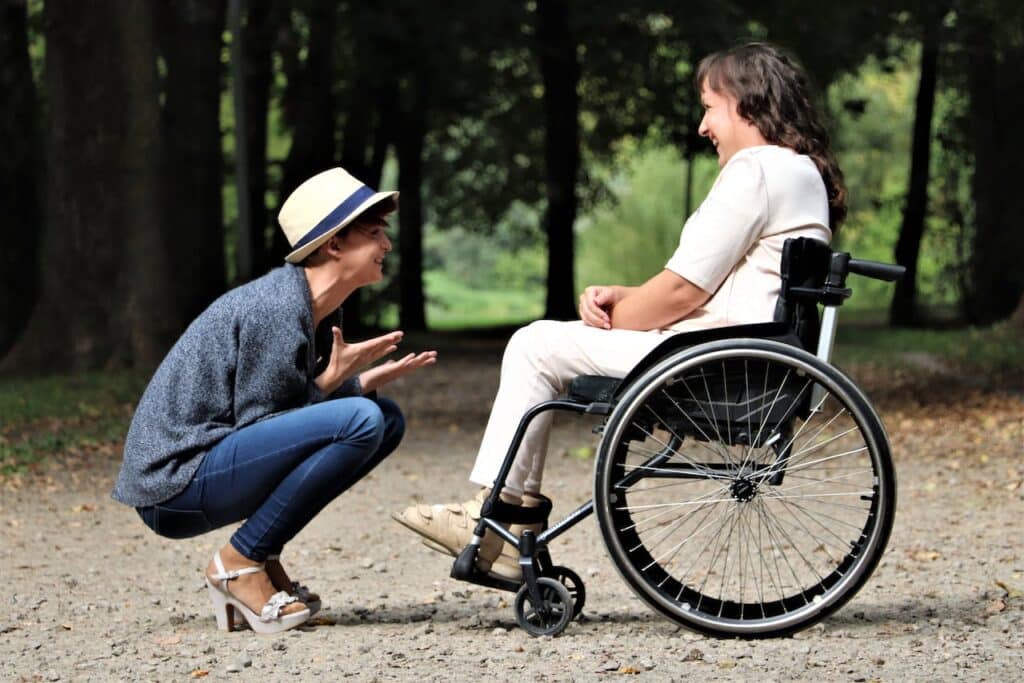Moving and Handling Techniques: Essential Safer Handling of People
Moving and handling technique refers to the correct and safe way of lifting, carrying, and supporting individuals to prevent injury for both the caregiver and the person being moved.
Moving and handling safety is one of the most important skills for people working in the health and social care sector.
It’s something that carers will come across most days at work and that’s why it’s crucial that the right moving and handling training is put in place to avoid any injury.
Luckily, there are a few essential techniques to follow when learning how to safely assist people without the risk of danger to you or your patient.
In this blog, we review the main techniques and plenty of advice on how to move and handle your patients safely.
Table of contents
- What does moving and handling mean?
- When might you need to move or handle someone?
- The risks of moving and handling
- Why you need specialised training
- What to bear in mind when lifting
- Equipment you might need for moving and handling people technique
- What is a moving and handling policy?
- The legislation to follow in moving and handling techniques
- The risk assessment on Moving and Handling Techniques
- Essential moving and handling techniques for safely assisting people
- Conclusion

Image by DCStudio on Freepik
What does moving and handling mean?
Moving and handling in terms of people just refers to the manual handling of people.
Others may also refer to it as manual handling, however it is not standard to say manual handling of people to differentiate from the manual handling of objects.
If you work in any type of care setting, you’ll ultimately come across many different situations in the workplace where you might need to move somebody or handle somebody for various reasons.
However, before you attempt to move anyone you need the right people moving and handling training first to make sure you can move people safely and securely with the right equipment and technique.
When might you need to move or handle someone?
There are many reasons why you may need to physically move or handle someone. Some of these reasons include:
- Helping someone up and out of bed
- Taking someone to the toilet
- Bathing or washing someone
- Helping someone with mobility difficulties
- Helping carry things for someone
- Moving objects or furniture for someone
- Helping someone get into and out of cars, buses etc
- Carrying food or other objects for someone
With all of these different tasks in mind, it’s important to remember any one of these tasks carried out with insufficient training could cause serious injury to you and your patient.
This is why it’s also important to receive the right training on how different types of equipment can help you to carry out these tasks as well.
The risks of moving and handling
Your back is one of the most vulnerable parts of your body when lifting or moving people.
Without adopting the right posture and technique, you could be left with serious back injuries that can severely limit your mobility and your ability to look after someone.
Other risks can include damaging fragile skin around your arms or hands, shoulder and neck injuries, breathing difficulties or even bruising and cuts around your body.
Any one of these injuries can severely impair your ability to look after people with some taking a long time to recover from.
This is why it’s so important to mitigate any potential risks to yourself and the patient when physically moving and handling.
Why you need specialised training
Specialised training tailored around different techniques to move and handle people in various situations is extremely beneficial to you and your employer.
This is because this training will show you exactly how to manoeuvre people safely, tips and tricks on how to position your body and also the types of equipment you can use to help you with each task.
Along with preventing any injury, having the right training also allows you to importantly prioritise promoting the dignity of those in your care.
This is also an important factor in moving and handling people and not treating them as objects to move around.
Other important benefits of receiving the right training include reducing staff sickness due to long-term injury, a better quality of care for all patients and being able to build more trust and confidence between yourself and your patient.
What to bear in mind when lifting
Before physically moving or lifting someone, it’s important to ask yourself a few questions to determine whether the person requires any aid.
This includes things like:
- Do they require any help to move?
- Do they just require some supervision?
- Have I yet told them I’m moving them?
- How heavy are they?
- Do I feel strong enough today?
- Could anyone help me?
- How long will it take to move them?
- Do I have enough space?
- Is anything in the way?
- Am I wearing appropriate clothing or footwear?
All of these questions in this checklist will help you to determine whether you’re making the right decision to move somebody.
Using this checklist also helps you to supervise someone sufficiently if they are capable of completing some tasks independently.
Enroll for our Moving and Handling training- See Course Calendar on Moving and Handling Training
Equipment you might need for moving and handling people technique
Another important aspect of learning how to move and handle people appropriately is learning how to use the right equipment for the right task.
There are many different types of moving and handling tools used in care settings. They assist in day-to-day tasks, such as safely getting patients out of bed and helping with dressing.
Let’s take a look at some of the most common types of equipment you can use to help you:
1. Hoists

Hoists are one of the most common and one of the most simple forms of equipment most care settings use to safely manoeuvre their patients.
They are most commonly used when attached to a ceiling following a track to help people stand up, lower them into a bath or lower people into a bed.
People who are non-weight bearing are more likely to use a hoist to help move them into different rooms.
2. Slings

There are many different variations of slings people can use to help move them.
This includes slings to lower people into a bath or onto the toilet.
They tend to provide a bit more comfort to whoever uses them and can be easily adjusted for those who have more fragile skin to help transfer them easily.
3. Slide sheets

Slide sheets are thin, smooth sheets made of low friction materials that are placed under the person needing to be moved.
Common materials include nylon, plastic, or specialised fabrics with a slippery surface.
Slide sheets help to easily move a patient with much less physical effort required. For example, sliding a person from a hospital bed to a stretcher or moving them higher up in bed.
Their low-friction material helps the patient to slide over the sheet during any manoeuvres, with the sheet being placed underneath them.
To use a slide sheet, caregivers roll the person to their side, place part of the sheet underneath them, then roll them the other way and position the rest of the sheet.
There are different types of slide sheet used in people moving and transferring. Slide sheet types can be broken into material, size, shape and features.
They can be disposable and reusable and can also be placed permanently under the patient.
Slide sheets come in differently sizes and can support hundreds of pounds when a team lifts and moves together. They are single-use or reusable.
4. Transfer boards
Transfer boards improve safety in moving and handling by enabling lateral sliding movements that minimise manual lifting effort and risks.
When used properly, transfer boards reduce friction and strain for both patients and handlers compared to manual transfers.
Transfer boards are used in a similar way to slide sheets in that they help to move patients from one position to another by placing the board underneath the patient.
They can help move someone from a bed to a chair and vice versa or from a seat to a wheelchair and vice versa.
Most carers use them along with slide sheets and even sometimes handling belts. Proper techniques are used to safely move patients onto the centered board, keep their body aligned, and pull the board to slide them across.
Multiple caregivers are often needed to coordinate the transfer using the board.
5. Handling belts
Handling belts are more to help supervise someone who is trying to move around or stand up.
It’s the perfect piece of equipment for people who can support some of their weight to help them stand and move.
However, they still need that extra bit of help to remain stable. They aren’t used for lifting, more just for extra support.
6. Turning aids
Turning aids are solely used to turn people around if they need to be placed in a different position.
They are also sometimes known as rota stands, turntables or turners for patients.
The main turning aids are:
- Turn sheets – these are sheets with handles
- Slide sheets – very smooth and slippery sheets
- Powered slide aids – electronically control sliding
Turning aids mean less lifting and pulling. They reduce friction so patients glide instead of being dragged.
They help prevent hurting patients’ skin or caregivers’ backs.
The team shares the weight using the handles. This helps turn even heavy patients.
7. Wheelchairs

Wheelchairs are one of the most recognised forms of moving and handling equipment. They are available in a variety of different types and for a variety of different needs.
Some are electric, some are manual, some are also able to recline and some are just for manually transporting people from one place to another.
9. Bed levers
Bed levers don’t technically classify as equipment that helps to move or handle people, but they do ensure the safety of patients while they are in bed.
They help to mitigate the risk of falls when lying in bed and can also be used by carers to help reposition the bed.
Bed levers allow the height and position of beds to be adjusted up, down, and tilted. This helps with moving and handling in several ways:
- Raising the Bed
- By raising the bed to a suitable working height, caregivers can avoid bending and lifting when accessing the patient. This protects backs.
- Tilting and Reclining
- Tilting parts of the bed makes it easier to raise patients to seated and standing positions. This reduces manual handling.
- Repositioning
- Adjusting bed height and alignment can help slide or reposition patients higher up or more centrally without heavy lifting.
- Transferring In and Out
- The bed can be height matched to wheelchairs or stretchers. This reduces the level change for patients transferring to other surfaces.
10. Electric beds
Electric beds work well for immobile patients or those who mostly depend on the help or supervision of a carer. They have an adjustable height and tailored positioning for the whole body.
They can also be used to help assist people from a seating to a standing position and vice versa.
Electric beds can be raised, lowered and tilted using electronic controls instead of manual levers. This makes it even easier to adjust them for safer moving and handling. This one tool that helps in performing techniques for moving and handling people safely.
Benefits of electric beds:
- Raising and Lowering
- Caregivers can bring the bed to the perfect work height electronically. This avoids awkward bending when caring for patients.
- Tilting and Reclining
- Electronic controls enable gentle tilting up to seated positions and reclining flat again. Much smoother than manual cranks.
- Repositioning
- Patients can be gradually raised and slid back into position electronically. No manual lifting needed.
- Transferring In and Out
- Electrics beds rise to match wheelchairs, stretchers etc precisely. This helps patients transfer off smoothly and safely.
Overall, electric beds improve moving and handling through touch-button height changes and powered tilting.
Things move more smoothly for both patients and caregivers. Handling is easier across all activities.
What is a moving and handling policy?
Most health and social care settings require some form of moving and handling policy that helps to ensure the safety of patients and carers.
This includes various aspects which include a formal statement on how the care setting mitigates any risks for moving and handling people.
This also includes determining who is responsible for ensuring safety and conducting required risk assessments. It involves action planning and providing necessary training for staff members.
Additionally, it encompasses equipment maintenance, staff compliance, and reporting any instances of pain or injuries by staff members.
Master Safe Patient Handling. Upskill With Our People Moving and Handling Training.
The legislation to follow in moving and handling techniques
Not only do you have to ensure the safety of patients in a care setting, but there are also pieces of legislation in the UK that you have to follow to be able to move and handle patients.
This legislation helps to create risk assessments.
The assessments ensure compliance and the safety of everyone involved in the process. Some of this legislation includes:
- Health and Safety at Work Act 1974
- Management of Health and Safety at Work Regulations 1999
- Provision and Use of Work Equipment Regulations 1998
- Manual Handling Operations Regulations 1992
The risk assessment on Moving and Handling Techniques
To follow these pieces of legislation, a sufficient risk assessment must be in place. All staff members should familiarise themselves with the risk assessment.
They should easily follow it, along with the patient’s care plans, to determine the best way to move and handle them. The main steps of a risk assessment include:
1. Identifying any potential hazards
This essentially means identifying any potential risks to any moving and handling activities. This includes any potential harm to patients and staff such as injuries or bad positioning.
You also have to identify how often you need to move and handle patients, what equipment you might use, what environment you move patients in and how you would move and handle patients in an emergency.
You also need to consider who may be harmed during these activities.
2. Evaluating potential risks
Thoroughly evaluating all of these risks and tailoring them to the individual patient’s needs and abilities becomes necessary.
It should also take into consideration changes throughout the day to the patient and determine the number of staff required to move them.
3. Controlling potential risks using moving and handling techniques
Controlling means determining what precautions to use in order to mitigate these risks, such as making decisions on the necessity of moving and handling. This includes putting the appropriate measures in place to control any risks.
4. Recording and reviewing
If there are 5 or more members of staff, it’s a legal requirement to record the risk assessment and to review them regularly. All staff members should familiarise themselves with the risk assessment.
They should easily follow it, along with the patient’s care plans, to determine the best way to move and handle them.
Essential moving and handling techniques for safely assisting people
Along with the rest of the advice we’ve provided, here are some of the essential techniques you should learn to safely assist anyone in your care:
1. Use an ergonomic approach (joint/back-protecting approach)
This essentially involves adapting your approach to suit both you and the patient you are looking after.
This means using the right equipment tailored to the patient’s care plan and also reducing the potential risk of manually moving someone.
You want to not only protect yourself and your capability of moving someone but also to keep the patient stable and secure.
Example of using a body-friendly approach
Joan needs to help Mrs. Harris get out of bed. Joan wants to move her in a body-friendly way.
- First, Joan checks Mrs. Harris’ care plan. It says to use a standing lift machine. The machine will do the hard work, not Joan’s back.
- Joan gets the lifting machine ready. She puts a special sling around Mrs. Harris. This keeps her comfy and secure.
- When Joan rolls the machine to the bed, she bends her knees. She keeps her back straight. This way Joan won’t get sore or tired.
- Joan makes sure the locks on the wheels are on. Then she starts lifting Mrs. Harris slowly up to stand. Joan talks to her in a calm way.
- When Mrs. Harris is on her feet, Joan waits. She gives Mrs. Harris time get steady before stepping. No need to rush.
By using the right equipment, moving carefully, and taking it slow, Joan protects both their bodies. This is being “body-friendly.”
2. Keep your knees relaxed
Keeping your knees relaxed allows you to distribute more even weight across your legs.
This helps to keep you more stable when lifting and moving the patient and also helps to prevent any injury to your lower back and legs.
Example to explain the point:
Here is a simple example to illustrate keeping knees relaxed during moving and handling:
- John is helping his grandfather get out of the bathtub. He wants to prevent strain on his own back and knees.
- As John reaches down into the tub, he makes sure to bend both his knees and hips. Keeping his knees slightly bent and loose helps share his body weight evenly through his legs into his feet.
- John asks his grandfather to put an arm around his shoulders. He grips under his grandfather’s arm with one hand and places the other on his wet back.
- “On three we’ll stand nice and slow, Grandad,” John says. “Keep your knees soft too.”
- John counts and they push up together. John isn’t locking or stiffening his knee joints. The soft bend lets him rock back as they find their balance.
- His relaxed knees act like shocks as John keeps his spine aligned. This takes pressure off his lower back compared to if his legs were rigid and straight.
By keeping flexible knees and sharing the lifting force between both their legs, John achieves better control and stability. His knees easily adapt to his grandfather’s movements without pain or strain.
3. Get as close as possible
You ideally want to get as close as possible to the patient. Being closer helps to keep you slightly more stable and also more comfortable while transferring your patient. This technique also helps to keep you more balanced while lifting.
Here is a simple example for getting close to the patient during assists:
- Maria needs to help her mother pivot from the couch to her wheelchair. She wants to be stable as she takes her mother’s weight.
- Maria approaches the front of the couch and slides one foot all the way to the edge, right against her mother’s knees. This closes the gap between them.
- Bending forward, Maria wraps her arm around her mother’s lower back. She grasps the far side rail of the wheelchair with her other hand.
- By eliminating space between their bodies, Maria won’t have to overreach or support her mother’s weight from a distance. Staying near is less straining.
- “I’ve got you tight, Mom,” Maria says. “Nice and close so we can turn together.”
- Maria counts down as she rotates her whole body in tune with her mother’s movement from sit to stand. Their connected stance keeps Maria balanced.
Getting as close as possible to her mother at the critical moment means Maria can use her own center of gravity and core strength to smoothly assist the transfer.
This prevents struggling with an awkward lean or lift.
4. Lead with your head
For both the patient and carer, your head should lead your whole body when moving.
This helps the movement of the patient when transitioning from seated to standing for example, but also helps the carer guide the patient more easily.
Here is an explanation on how to leading with your head:
- When Jasmine helps her dad stand up from his chair, she makes sure to keep her head pointing forward. She looks towards the empty space in the living room where they will walk.
- As Jasmine takes her dad’s arm, she turns her head and says “This way, Dad”. Her eyes stay focused on where they are walking to.
- When her dad pushes up to stand, Jasmine keeps looking ahead. She doesn’t look down or turn her chin behind her.
- Keeping her head and eyes aimed forward helps pull her dad’s body into upright walking. It helps Jasmine guide him properly.
- By keeping her head pointed to the front, facing where they need to go, it makes the path clear for her dad to follow. This keeps him steady as they start stepping slowly.
Leading with her vision can prevent falls or missteps. It allows Jasmine to support her dad’s movements in a safe, careful way from sitting all the way to the walking area.
5. Follow the sit-to-stand moving and handling techniques
When you need to get a patient on their feet, the best way to do this is to carry out the sit-to-stand technique.
This means communicating clearly with the patient with the right gestures and support to gently lift the patient from behind while also encouraging them to push their body weight.
You can also use this technique from lying down to sitting. Never just forcefully pull someone out of their chair or bed.
Example:
- Maria needs to help her grandmother stand up from the couch. She will use the sit-to-stand method slowly and gently.
- First, Maria faces her grandmother and bends her knees and hips to get close. She reaches one arm around nana’s lower back for support.
- Maria says “Nana, let’s stand together nice and slow when you’re ready. I’ll help lift from under your backside.”
- When her grandmother nods, Maria counts “1, 2, 3, up” as they raise together – her grandmother pushing up with her legs as Maria lifts from under her arm and back.
- Once standing Maria makes sure her nana is steady before taking any steps.
- For lying to sit, Maria would roll her nana onto her side first. Then Maria would provide support from behind into an upright position.
Maria never pulls hard or yanks from the front. The sit-to-stand lift is always controlled and patient to prevent harm.
Conclusion
When helping people move, there are some important things carers should do.
- Get close, bend knees, keep back straight
- Use smooth, gentle motions together
- Lead with the eyes/head facing forward
- Use special sliding sheets and equipment
These things help prevent injury and falls. They make moving safer for the carer and more comfortable for the person.
Carers also need proper training to learn the best ways.
Caring for Care has a half-day class just for practising moving and handling skills hands-on. People can take a Basic Life Support class the same day too.
Learning by doing with an instructor gives carers more confidence to use these body-friendly methods. It helps folks provide proper care while avoiding harm.
Let us Help you
We’ll help you find the right course for your needs. Tell us a little bit about your situation and what you would like to achieve.
We’ll get back to you within one working day.
